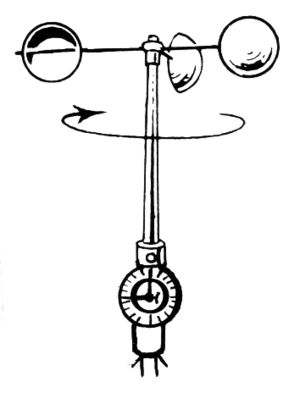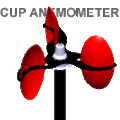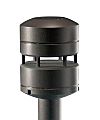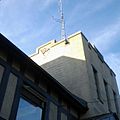Anemometer facts for kids
An anemometer is a special tool used to measure how fast the wind is blowing. You can find them at most weather stations, which are places where scientists study the weather. The word "anemometer" comes from an old Greek word called ἄνεμος, meaning wind. It describes any tool that measures wind speed for studying weather or how things move through the air. A smart person named Leon Battista Alberti first talked about an anemometer around 1450.
Contents
What is an Anemometer?
An anemometer is a device that helps us understand the wind. It tells us how strong the wind is. This information is super important for many reasons. For example, knowing wind speed helps pilots fly safely. It also helps sailors on boats and even farmers planning their crops. Weather scientists use anemometers to predict storms and understand climate patterns.
How Anemometers Work
Most anemometers work by using the wind's force. When wind pushes against parts of the anemometer, it makes them move. The faster the wind blows, the faster these parts move. The anemometer then turns this movement into a measurement of wind speed. Some types count how many times a cup spins around. Others might use sound waves or even lasers to figure out the speed.
Different Kinds of Anemometers
There are many types of anemometers, each working a bit differently. Here are some common ones:
Cup Anemometers
- These are the most common type you might see.
- They have three or four cups attached to a central pole.
- The wind catches the cups, making them spin around.
- The faster the cups spin, the stronger the wind is.
- This type was invented in 1846 by John Thomas Romney Robinson.
Vane Anemometers
- Vane anemometers look a bit like a small propeller.
- They have a propeller that spins when the wind blows through it.
- They often have a tail, like a weather vane, to point into the wind.
- This helps them measure the wind speed accurately in the right direction.
Ultrasonic Anemometers
- These are more modern and don't have moving parts.
- They use sound waves to measure wind speed.
- The device sends sound pulses between different points.
- The wind affects how fast the sound travels.
- By measuring these changes, the anemometer calculates wind speed and direction.
- They can measure wind in two (2D) or three (3D) directions.
Hot-Wire Anemometers
- These anemometers use a very thin, heated wire.
- When wind blows over the wire, it cools it down.
- The device measures how much electricity is needed to keep the wire hot.
- More wind means more cooling, so more electricity is needed.
- This helps measure very small changes in wind speed.
Pitot Tube Anemometers
- These are often used on airplanes.
- They measure the difference in air pressure.
- One opening faces the wind, and another measures the surrounding air pressure.
- The difference between these pressures tells us the wind speed.
Images for kids
-
A hemispherical cup anemometer of the type invented in 1846 by John Thomas Romney Robinson.
-
Britannia Yacht Club clubhouse tour, burgee, and wind gauge on roof
-
Helicoid propeller anemometer incorporating a wind vane for orientation
See also
 In Spanish: Anemómetro para niños
In Spanish: Anemómetro para niños


















